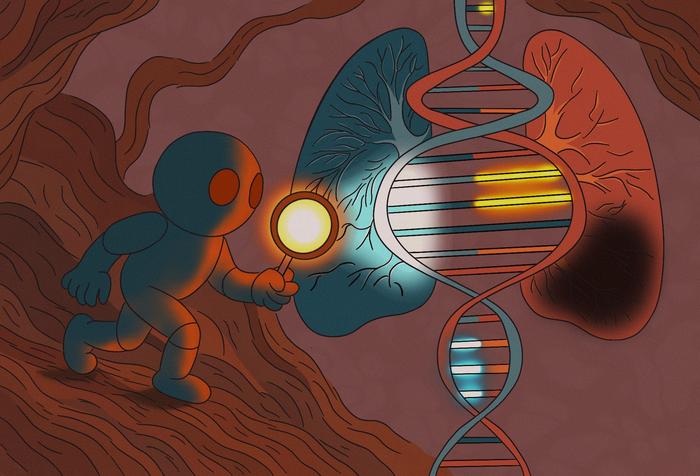In an unprecedented advancement at the intersection of biophysics and artificial intelligence, a research team from Northwestern University has engineered a groundbreaking computational framework capable of unmasking the intricate gene interactions responsible for complex diseases. Conditions such as diabetes, cancer, and asthma have long eluded definitive genetic explanations due to their multifactorial nature, where multiple genes cooperate in complex networks rather than acting independently. This novel approach not only confronts but transcends these challenges by leveraging generative AI to decipher elusive patterns of gene expression that underpin these disorders.
The complexity inherent to diseases influenced by gene networks presents formidable obstacles; the vast combinatorial possibilities of gene sets make traditional analytical methods insufficient. Unlike monogenic disorders, which stem from mutations in single genes, complex diseases arise from coordinated dysregulation among numerous genes, a phenomenon obscured by sheer data dimensionality and statistical limitations. To overcome this, researchers have turned to advanced machine learning methodologies, culminating in the creation of the Transcriptome-Wide conditional Variational auto-Encoder, or TWAVE. This generative model amplifies sparse gene expression datasets, enabling the identification of causal gene ensembles that drive pathological states.
TWAVE’s capacity to simulate both diseased and healthy cellular states through limited but high-quality gene expression data is revolutionary. Gene expression profiles offer dynamic insights far beyond static DNA sequences, capturing temporal and environmental influences on cellular behavior. The model thus pivots from mere genotype analysis towards an integrated genotype-phenotype framework. Instead of isolating individual gene contributions, TWAVE systematically uncovers collective gene effects that propagate complex traits, pinpointing key players whose combined activity shifts cellular states. This paradigm shift allows researchers to transcend the reductive simplicity of single-gene associations and capture the multigenic orchestration of disease.
The methodology capitalizes on a fusion of machine learning and optimization algorithms to enhance interpretability and causal inference. By training on clinical trial datasets with well-characterized expression states, TWAVE aligns gene expression perturbations with phenotypic manifestations. Moreover, experimental perturbation data, elucidating gene network responses to activation or suppression, refine the network inference, thus enhancing biological plausibility and predictive utility. This sophisticated interplay between data-driven modeling and experimental grounding highlights TWAVE’s potential in precision medicine.
Environmental modulation of gene activity further complicates the genetic landscape of complex traits. Traditional genomic studies often neglect these influences because DNA sequences remain constant regardless of environmental context. However, gene expression profiles fluctuate in response to external stimuli, offering a real-time depiction of cellular adaptation. TWAVE’s reliance on expression data elegantly integrates these environmental effects, providing a more holistic understanding of disease etiology. This dynamic integration signifies a critical leap forward in unraveling the genotype-to-phenotype enigma.
The implications of this approach extend beyond theoretical insights, promising tangible clinical applications. TWAVE has been validated across multiple complex diseases, demonstrating its superiority over conventional genome-wide association studies that often fail to detect subtle gene-gene interactions. Notably, it identifies gene sets that have previously eluded detection, underscoring the model’s sensitivity and robustness. Intriguingly, the research reveals interindividual heterogeneity in genetic drivers, suggesting that diseases traditionally classified under a single umbrella may, in reality, represent diverse molecular syndromes requiring personalized therapeutic strategies.
This personalized dimension is crucial in an era striving for precision medicine. Different patients manifesting phenotypically similar diseases may harbor distinct causal gene constellations, influenced by their unique genetic backgrounds, environmental exposures, and lifestyles. TWAVE’s ability to delineate these differences lays the groundwork for bespoke treatments, targeting patient-specific gene networks rather than one-size-fits-all interventions. Such precision could transform therapeutic efficacy and reduce adverse effects by tailoring interventions at the molecular level.
The significance of focusing on gene expression over gene sequence lies in its ethical and practical advantages. Because expression data sidesteps many privacy concerns associated with DNA sequencing, it facilitates broader data sharing and integration, accelerating research and discovery. Additionally, gene expression captures epigenetic and post-transcriptional regulatory influences, offering a richer, more functional perspective on genetic contributions to disease.
Senior author Adilson Motter, a physicist specializing in complex systems, likens the disease mechanism to an airplane crash requiring multiple concurrent failures. This analogy encapsulates the essence of polygenic traits: the convergence of multiple subtle genetic perturbations resulting in disease phenotypes. Motter’s vision is to disentangle these convoluted networks, bringing clarity to the chaos of biological complexity through TWAVE’s generative framework.
The model’s development reflects a multidisciplinary synergy, combining expertise in physics, computational biology, and genetics. Postdoctoral researcher Benjamin Kuznets-Speck, graduate student Buduka Ogonor, and research associate Thomas Wytock contributed extensively, integrating algorithmic innovation with biological insight. Their collective efforts underscore the necessity of collaborative research frameworks to tackle the most daunting challenges in biomedical science.
This pioneering research received support from esteemed institutions, including the National Cancer Institute, the National Science Foundation, and the Simons Foundation. The study’s forthcoming publication in the Proceedings of the National Academy of Sciences marks a milestone in computational biology and genomics, promising to catalyze further innovation in understanding and treating complex diseases.
In sum, Northwestern University’s TWAVE represents a monumental stride in biomedical research, harnessing generative AI to elucidate the complex genetic architectures of diseases long deemed inscrutable. By transcending traditional approaches and embracing the dynamic intricacies of gene expression, this tool opens new vistas for personalized medicine, promising a future where diagnostics and therapeutics are profoundly precise and tailored to the individual molecular landscapes that define human health and disease.
Subject of Research: Computational modeling of gene expression to identify causal gene sets underlying complex diseases
Article Title: Generative prediction of causal gene sets responsible for complex traits
News Publication Date: 9-Jun-2025
Web References:
DOI link
References:
Motter, A.E., Kuznets-Speck, B., Ogonor, B., & Wytock, T. (2025). Generative prediction of causal gene sets responsible for complex traits. Proceedings of the National Academy of Sciences. DOI: 10.1073/pnas.2415071122
Image Credits: Camila Felix
Keywords: Genotypes, Complex traits, Phenotypes, Gene expression, Genome dynamics, Medical genetics, Genetic disorders, Artificial intelligence, Generative AI




